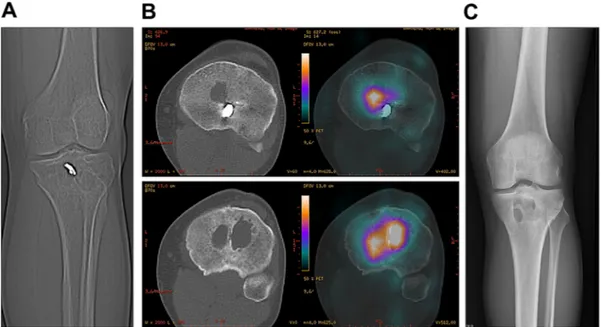Reactivation of Clostridium tertium bone infection
30 years after the Iran
–Iraq war
Emilie Virot,
1Elvire Servien,
1,2Frederic Laurent,
1,2,3Tristan Ferry,
1,2,3on behalf of the
Lyon Bone and Joint Infection Study Group
1Hôpital de la Croix-Rousse,
Hospices Civils de Lyon, Lyon, France
2
Université Claude Bernard Lyon 1, Lyon, France
3
Centre International de Recherche en Infectiologie, CIRI, Inserm U1111, CNRS UMR5308, ENS de Lyon, UCBL1, Lyon, France Correspondence to Dr Tristan Ferry, tristan.ferry@univ-lyon1.fr Accepted 27 January 2015
To cite: Virot E, Servien E, Laurent F, et al. BMJ Case Rep Published online: [please include Day Month Year] doi:10.1136/bcr-2014-209169
DESCRIPTION
A 40-year-old-man presented with left knee pain
(during night and day) for 3 weeks. He has a
history of left knee injury from shrapnel contracted
in 1987 during the Iran
–Iraq war (the patient did
not experience cellulitis, loss of function or any
other symptom immediately following the injury).
At the time of physical examination 30 years later,
a small curved scar facing the tibial tuberosity was
seen, without
fistula, without local signs of
inflam-mation and without knee arthritis. X-ray showed
bony lysis of the proximal tibia around a foreign
metal object (
figure 1
A). CT scan combined with
granulocyte-labelled scintigraphy showed
recruit-ments of polymorphonuclear cells within the bone
lysis (
figure 1
B). Tibiotomy was performed to
extract the piece of shrapnel. A
gentamicin-impregnated spacer was used to
fill the bone cavity,
which was later removed. Two of the four bone
samples revealed late growth of
Clostridium
tertium, which was susceptible to penicillin. The
patient received amoxicillin and pristinamycin
during a course of 12 months. The evolution was
favourable (
figure 1
C).
C. tertium is a non-toxic aerotolerant
Gram-positive bacillus that forms spores in aerobic
conditions.
It
is
often
misidenti
fied with
Corynebacterium spp, Lactobacillus spp or Bacillus
spp
. C. tertium could be responsible for soft tissue
infection or bacteraemia in immunocompromised
hosts.
1 2Bone and joint infection due to
C. tertium
is rarely described in the literature. Greidlein
et al
3reported 37 cases of septic arthritis due to the
Clostridium
species,
including
one
case
of
C. tertium arthritis, which was also associated with
a metal fragment. The management of
implant-associated
C. tertium infections requires extraction
of the foreign body and prolonged antimicrobial
therapy.
Learning points
▸ Clostridium tertium could be responsible for
late metal fragment bone and joint infection.
▸ Late C. tertium metal fragment bone and joint
infections requires a multidisciplinary
management.
▸ Late C. tertium metal fragment bone and joint
infections requires metal extraction and
prolonged antimicrobial therapy for healing.
Collaborators Lyon Bone and Joint Infection Study Group: Physicians—TF, Thomas Perpoint, André Boibieux, François Biron, Florence Ader, Julien Saison, Florent Valour, Fatiha Daoud, Johanna Lippman, Evelyne Braun, Marie-Paule Vallat, Patrick Miailhes, Christian Chidiac and Dominique Peyramond. Surgeons—Sébastien Lustig, Philippe Neyret, Olivier Reynaud, Caroline Debette, Adrien Peltier, Anthony Viste, Jean-Baptiste Bérard, Frédéric Dalat, Olivier
Figure 1
(A) X-ray of the tibia showing the foreign body and the bone lysis. (B) CT scan combined with
granulocyte-labelled scintigraphy showing a recruitment of polymorphonuclear cells within the bone lysis. (C) X-ray of
the tibia 3 years after the treatment.
Virot E, et al. BMJ Case Rep 2015. doi:10.1136/bcr-2014-209169 1
Cantin, Romain Desmarchelier, Michel-Henry Fessy, Cédric Barrey, Francesco Signorelli, Emmanuel Jouanneau, Timothée Jacquesson, Pierre Breton, Ali Mojallal, Fabien Boucher and Hristo Shipkov. Microbiologists—FL, François Vandenesch, Jean-Philippe Rasigade and Céline Dupieux. Imaging—Loïc Boussel and
Jean-Baptiste Pialat. Nuclear Medicine—Isabelle Morelec, Marc Janier and Francesco Giammarile. PK/PD specialists—Michel Tod, Marie-Claude Gagnieu and Sylvain Goutelle. Clinical Research Assistant—Eugénie Mabrut.
Contributors EV and TF wrote the case; ES participated in the patient’s care and the literature review; FL participated to the literature review.
Competing interests None. Patient consent Obtained.
Provenance and peer review Not commissioned; externally peer reviewed.
REFERENCES
1 Fujitani S, Liu CX, Finegold SM, et al. Clostridium tertium isolated from gas gangrene wound; misidentified as Lactobacillus spp initially due to aerotolerant feature Shigeki.
Anaerobe2007;13:161–5.
2 Vanderhofstadt M, André M, Lonchay C, et al. Clostridium tertium bacteremia: contamination or true pathogen? A report of two cases and a review of the literature.Int J Infect Dis2010;14(Suppl 3):e335–7.
3 Gredlein CM, Silverman ML, Downey MS. Polymicrobial septic arthritis due to Clostridium species: case report and review.Clin Infect Dis2000;30:590–4.
Copyright 2015 BMJ Publishing Group. All rights reserved. For permission to reuse any of this content visit http://group.bmj.com/group/rights-licensing/permissions.
BMJ Case Report Fellows may re-use this article for personal use and teaching without any further permission. Become a Fellow of BMJ Case Reports today and you can:
▸ Submit as many cases as you like
▸ Enjoy fast sympathetic peer review and rapid publication of accepted articles ▸ Access all the published articles
▸ Re-use any of the published material for personal use and teaching without further permission For information on Institutional Fellowships contact consortiasales@bmjgroup.com
Visit casereports.bmj.com for more articles like this and to become a Fellow
2 Virot E, et al. BMJ Case Rep 2015. doi:10.1136/bcr-2014-209169
